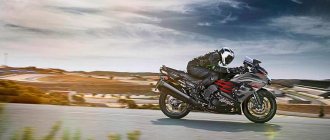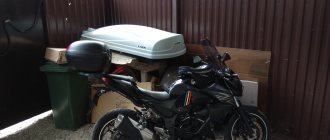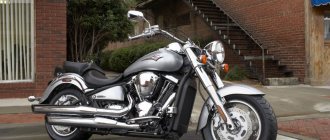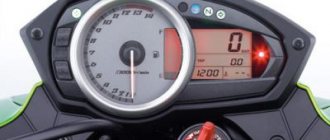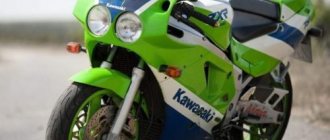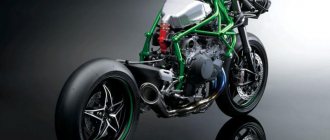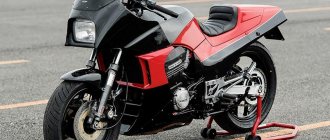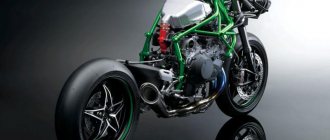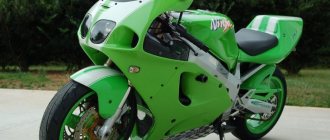Sportbike Kawasaki Ninja 650 2020
Going into a turn, I feel like a boy - this is exactly how I imagined riding a motorcycle in my distant youth: feet with toes on the pegs, head forward, looking into the turn, a filigree trajectory written out by a single bike-rider. The Kawasaki Ninja was the first bike I wanted - the first one to appear on my wall as a poster, the first one I found in magazines and read about voraciously.
Advantages of the bike
Here are the main advantages of this wonderful model:
- high speed with good handling;
- design at the art level;
- excellent filling, putting it on a par with the advanced motorcycles of the time.
The motorcycle has several distinctive features. An electronic system is used to start the engine. The frame of the motorcycle is of the “birdcage” type. As for the rest of the features, they are very typical for classic bikes. But at the same time, these features are better than most motorcycles in this class.
The Kawasaki Ninja 650 R is an excellent example of a motorcycle of medium ambitions. Despite the sporty design, this is not a super-fast bike, it is an ordinary classic motorcycle that sets the bar for quality in its niche.
Flaws
No obvious disadvantages were noticed, but what I would like to change (due to nitpicking):
- Weak bulbs in the headlight. The closest one is nowhere, the farthest one is a little better. Changed by installing xenon
The naked bike has one irregularly shaped headlight.
In the tourist version there are two fox eyes.
- Vibrations. Any gear, any speed - the motorcycle vibrates. On trips over short distances this doesn’t really bother us (vibration is not transmitted to the controls), but on long trips it just gets annoying. Unfortunately, another feature of the motor is incurable.
- Wide steering wheel. Although the bike is quite narrow, a wide handlebar will not allow you to “shoot through the aisles.”
Specifications
In terms of its technical parameters, the motorcycle is not exactly ahead of its time, but definitely keeps pace with it: its engine, transmission, chassis and brakes are completely suitable for a bike of this size. The elements of the product are balanced and harmonize with one another, which is very important. There are models where, with an overly powerful engine, the brakes and the like are not strong enough.
Competitors
But the situation with competitors is unusual. Although the ER-6 is one bike, but in a different configuration, representatives of other “Japanese” called the models different and presented their answers for each - for the ER-6n and ER-6f.
For ER-6n
Honda NC700 (NC750)
- road builder + enduro tour;
- start of production in 2012;
- the engine is the same, but tilted forward - 55°;
- volumes - 669 and 745;
- in both cases the injector is of our own design;
- release continues.
A distinctive feature was the single-disc front brake, but with the possibility of obtaining a combi-brake (both are activated when the handle is pressed) as an option.
Suzuki SFV650 Gladius
- naked;
- start of production - 2009;
- 2 cylinders in V-shaped design;
- pumping 645 cm³;
- closed in 2015.
The main distinguishing feature was SDTV - 2 dampers in the cylinders.
Yamaha MT-07
- naked;
- start of production - 2014;
- the engine is a complete analogue of Kawasaki;
- exhaust 689 cm³;
- production continues.
The difference is 4 pistons on the front brake disc and digital ignition
For ER-6f
Honda CBF600S
- naked in plastic (sport-tourist);
- production started in 2004.
- engine capacity - 599 cm³;
- injector of our own design (since 2008);
- closed in 2013.
Suzuki GSX650F
- sports tourist;
- start of production - 2008;
- engine capacity - 656 cm³;
- closed in 2021.
The main differences were SDTV, a 4-cylinder engine and brake calipers (4 pistons per disc for the front axle, 2 for the rear).
Yamaha XJ6 Diversion
- sports tourist;
- start of production - 2009;
- engine bypass - 600 cm³;
- closed in 2021.
Engine
The motor has two cylinders. It is four-stroke, and its type is in-line. This motor is perfect for this motorcycle. The working volume is 649 cubic centimeters. This is enough to provide the required power.
At 6500 rpm the torque is 65.7 Newton meters. This indicator largely allows the motorcycle to develop serious speed, and its acceleration is significant. The power of the bike is large and gives it good traction: at maximum, the power of the Kawasaki Ninja 650 R is 68 horsepower, while the number of revolutions per minute is 8000.
The engine is equipped with the following timing system: DOHC, and it has 8 valves. The compression ratio in the engine is 10.8:1. The engine is liquid cooled. In general, the engine fully complies with all standards and is capable of providing a fast and comfortable ride. In addition, this engine is very durable.
Is the Kawasaki ER 6n worth buying?
As noted above, modern Japanese bikes are almost without exception high quality, reliable and productive. The problem of choice comes down to the financial capabilities of the potential buyer and his design preferences. If you liked the ER 6n at first glance, it is definitely worth purchasing - the technical characteristics of the motorcycle will not disappoint.
Overall, the Kawasaki ER 6n will be an excellent vehicle for a young and self-sufficient entrepreneur or manager who does not like to languish in city traffic jams
If you need to constantly make country trips, it is more logical to pay attention to models with more massive fairings. Most likely, experienced reckless racers should also give up the stylish Japanese car, since the characteristics of the Kawasaki ER 6n are designed more for comfortable and maneuverable riding within the city than for crazy sprints
Dimensions and weight
The wheelbase of the motorcycle is 1410 millimeters, which is quite enough for a classic mid-ranger. The length of the bike is small - only 2055 millimeters. The width matches the length and is 740 millimeters. The saddle height is average, reaching 790 millimeters. The height of the motorcycle itself is 1135 millimeters.
With such average dimensions, the motorcycle also has a quite suitable average weight - 193 kilograms. From all of the above it follows that the bike is well suited for people of average height and physical strength. If a person who is too tall chooses such a motorcycle, the handlebars will simply rest on his knees. At the same time, a rider who is too short will experience other difficulties with landing and control.
Inconvenience in the driver's seat of a vehicle is a very unpleasant and dangerous factor that should not be allowed.
Tuning features
Every owner wants his bike to have a unique styling. To achieve this result, tuning is used. It can be external, engine tuning and chassis. External work includes painting, replacing fairings, handles, stickers, and mirrors. It is done mainly for “show-off” or to give the motorcycle an aesthetic appearance. A motor conversion is an improvement in the power output of a bike by replacing some of the factory parts with others or eliminating them if necessary. When the chassis is replaced, the wheels, brake system, clutch, suspension, or, in other words, everything that can improve its technical capabilities are replaced.
Tuning the appearance of the Kawasaki ER-6N. Profile view.
Chassis and brakes
The motorcycle frame is made of high-strength steel. She conveys all the energy of this monster, his desire to hit the road. The exterior as a whole is more typical for sports models; it also has its own “zest”. It consists of particularly sharp contours of the aerodynamic body, which are definitely a design move.
The car's suspensions do their job well, providing a comfortable and safe ride. The rear suspension of the bike is horizontal and has reverse thrust. There is a spring preload adjustment. The front suspension of the motorcycle is represented by a telescopic fork with dimensions of 41 millimeters.
The discs are cast products. Their design matches the aggressive color of the bike: slightly curved elements of the rims seem to speak of the hidden capabilities of their two-wheeled owner.
The steering wheel of the car is small compared to the usual steering wheel of a cruiser. Such a small handlebar makes it easy to control the motorcycle at high speeds. In addition, it looks very stylish, especially considering the nearby mirrors.
The brakes are also doing well. The rear one is a petal disc with a diameter of 220 millimeters. There is a single piston caliper. At the front, the brakes are 2 semi-floating petal discs, each with a diameter of 300 millimeters. There is a two-piston caliper.
Test drive Kawasaki Z650: rough, mix, but don’t shake
The new Kawasaki Z650 appeared on the market not long ago, replacing the second generation Kawasaki ER6 on the assembly line. There are many innovations, including a different chassis, a redesigned engine and a new name Z650, but how far is the new product from its predecessor? Let's try to figure it out.
The history of Kawasaki mid-sized road bikes with parallel twins began back in 1997, when the Kawasaki ER-5 saw the light of day. The classic road bike with a 498 cc, fifty-horsepower engine and a steel frame was warmly received by the public, but real success came to Kawasaki later, with the release of a completely new mid-size ER-6 in 2006.
Video version of the Kawasaki Z650 2021 test drive:
Formally, the motorcycle was the successor to the ER-5, although the power of the 649 cc twin increased to 72 horsepower; the main difference was the new chassis. In their fanatical desire to make the chassis more compact and sharper, the engineers abandoned two rear shock absorbers, installing one, but on the side.
It was this original solution, coupled with a muffler located under the engine, that became a huge success both in Europe and Japan, and our compatriots appreciated the simple, reliable and quite pleasant motorcycle. “Ruff” was produced both in the hooded version of the ER-6f (in some markets as the Ninja 650R) and in the “stripped” ER-6n until 2012, when the second generation of the model was released.
The second generation ER6n received a new index Z650
In fact, it was a deep modification of the first one: a new frame, different suspensions for the old engine, minor changes in settings and a completely new design - the motorcycle became a little more relevant, thanks to which it lasted on the assembly line until 2021, when it was replaced by a new generation, called the Z650 . But is it really that new?
The name is accurate: probably in Japan they decided to reduce the number of families of their motorcycles, which is why from now on the “naked” motorcycle is called the Z650, and the hooded one, rolled up in plastic, is called the Ninja 650, in fact, being one and the same motorcycle, the devices belong to different families. No more “Ruffs”, everything is grown-up.
Not to say that the number of innovations makes your head spin, however, there are enough of them to talk about a new motorcycle
The frame and chassis are also new. At all. Yes, these are still steel pipes, but in the new rear suspension the monoshock absorber is located not on the side, but in the center, but the main thing is that from now on it has received a progressive characteristic. It’s interesting that in last year’s test of the new Ducati Monster 797, which is a direct competitor to the Z650, the rear suspension was copied exactly from the ER-6 - a monoshock on the side, without progression. Who would have thought that the Italians would once again start looking for solutions from the Japanese?
The rear shock absorber has returned to its usual place
However, the goodies end at the rear suspension - the classic telescopic fork seems to have not changed at all, as evidenced by the previous pipe diameter of 41 mm, and the travel remaining at the old level of 125 mm and the stiffness adjustment that never appeared. Here's your grandma and the new model! The same applies to the brakes - a pair of “floating” two-piston calipers at the front, coupled with 300 mm discs, seem to have been left untouched, carried over from previous generations.
Front fork – classic telescope with 125 mm travel
The same applies to the rear 220 mm brake disc, working in tandem with a single-piston caliper. There is also ABS, which, it feels like, has not evolved much either. Why change anything? There were no special complaints about the old ones, and buyers of new motorcycles will only be happy, because on the one hand they have a completely new model in the garage, on the other hand, all consumables and spare parts can be found in any village. Perfect!
Nissin mechanisms equipped with an anti-lock braking system are responsible for effective braking.
Of course, if you are not too concerned about such little things as feedback buried under swelling rubber lines and “floating” brackets, the transparency and linearity are not the best, and you do not place excessive demands on the rigidity of a classic telescope. In other words, if driving on a track or setting the next best time for passing the Yauza embankment is not your thing, but comfortable movement to the office, to the dacha and to the pub, without problems and traffic jams, is a priority - a motorcycle chassis will be enough for you.
The power plant provides decent dynamics both in the city and on the highway
And not only for one season - the decent dynamics of the 68-horsepower engine, an honest 200 km/h maximum speed and the general simplicity of the device make it a normal choice as a device for a long time. And he runs this notorious “long” without any problems, because the engine, with the exception of the stranglehold thrown by environmentalists, has changed only externally.
The engine is a 649 cm3 in-line twin, familiar from the previous generation.
Inside, everything is the same as 10 years ago: 649 cm3, a pair of cylinders with a diameter of 83 mm and a piston stroke of 60 mm, 4 valves per cylinder, a pair of camshafts, so, unlike many of its classmates, the Z650 engine can be called reliable in advance. The same applies to the 6-speed gearbox and multi-plate “wet” clutch. Why change something that already works great, right?
The appearance of the motorcycle has also undergone significant changes.
But the design was significantly re-sawed - the plastic was completely changed, the shape of the saddle, which became separate in the Z650, the tank, tail, optics, but... The motorcycle did not look any better: there is a very unique shape, so beloved by green designers, and fashion trends, ceased to be such about seven years ago. Even the optics, even though they were of a new form, remained on archaic incandescent lamps!
Kawasaki Z650 looks quite modern, although in some places it is frighteningly simple
With the exception of the LEDs in the taillight, there are even bulbs in the turn signals! Horrors of the Middle Ages! Thank you for not acetylene lanterns, damn it, and not kerosene lamps. However, what am I? In fact, incandescent lamps have one big advantage: if they happen to burn out, a replacement can be found not even in auto parts, but in any hypermarket or at any large gas station and it will cost three kopecks.
The rear light sports the now fashionable LEDs.
At the same time, a dead diode headlight will first force you to get to your destination by touch, and then remember about the remaining paired internal organs that can still be sold to buy a new headlight. In short, the light bulbs only look outdated, but with the exception of aesthetics, then there are solid advantages and the motorcycle cannot be blamed for this.
All optics, not counting the rear light, remained on classic incandescent lamps. Is it good or bad - decide for yourself
The monochrome dashboard with an original tachometer, the needle of which runs along a monochrome digital scale, looks ambiguous: on the one hand, it is original, and there is enough information content, on the other hand, in 2021, to see a monochrome monitor on a motorcycle with an engine whose volume exceeds 250 cc, like - that's strange.
The dashboard with carbon-look elements is quite informative, although the appearance is not for everyone
But, and here the Japanese have really succeeded, despite all the problems with finding original but pleasant forms, the strength of narrow-eyed designers is the ability to work with colors and textures: here is silver semi-matte paint, here is black gloss, and here, if you please, is unpainted plastic with an unusual texture ! They even got confused with the material for the saddle cover, which, depending on the lighting, looks like a million small ice floes of the North Pole, or a skin torn from some very small leopard.
But for the seat material, which changes color depending on the lighting, we send our warmest regards to Kawasaki designers!
In other words, if you, unlike me, have not been spoiled by polished European design studios, diodes, color monitors and other keyless access, the new Z650 will not cause rejection. Who knows, you might even find your thrill in a plastic tank cap? By the way, the plastic is incredibly flexible and soft, so much so that it seems that after a fall all the damage will be reduced to just scratches! The Japanese know a lot about it.
With reasonable throttle operation, a 15-liter tank will last for more than 300 km
But the remote controls, even though they look nice and feel solid, seem to have come here from the last century. Where are the backlights, where are the joysticks and other touchpads? Nothing but the necessary and familiar, but there’s absolutely nothing to break here. The same applies to the levers on the steering wheel, which have simple and convenient adjustment, and the moderately soft saddle without height adjustment. In other words, the perfect butt carrier for every day!
Classic remotes don't take much time to get used to
And it’s not at all boring on the go: the rear wheel effortlessly gets up from the gas, the clutch is soft, the engine is enough from the beginning to the end of the tachometer scale, the gearbox is Japanese-style precise and soft, everything here works perfectly! But, adjusted for purpose, this is not a motorcycle that accelerates well after 140 km/h, and not one that can be shifted from knee to knee, squealing with delight, the fork is too weak.
In 2021, the price tag for the Kawasaki Z650 starts from 565,000 rubles
But for daily trips it’s better not to think of it. It's like Renault Logan or Hyundai Solaris, simple, reliable and not too expensive, a reasonable 565 thousand rubles. However, if you already have a Kawasaki ER-6, and especially if it has ABS, you shouldn’t rush to sell it off at half price to the carprice hucksters and run for a new Z650, you simply won’t feel the difference. The Kawasaki Z650 is a motorcycle that is bought not with the heart, but with the head, because in terms of its totality of qualities it is perhaps the best choice for every day.
We thank Fuji Motors for providing us with a motorcycle for testing.
Accreditation and organization of test drives – Denis Sokolov | | +7 (999) 851-49-71
Kawasaki ER-6f - Brief Review
Kawasaki ER-6f / Kawasaki ER-6f
The Kawasaki ER-6f motorcycle is an excellent example of a quality street bike, which is distinguished by its compact size and flexible sporty handling. Its design uses a durable frame made of steel pipes. An in-line power unit is mounted on it using anti-vibration dampers, creating increased torque for a confident ride.
The good handling of the Kawasaki ER-6f motorcycle is due to its low center of gravity and ergonomic seating position with reduced footrest distance. The unique design of the motorbike is emphasized by the smooth lines of the body, racing wheels, a centrally located muffler and an offset shock absorber of the adjustable suspension.
The Kawasaki ER-6f bike is equipped with an aerodynamic fairing and windshield, as well as a rear fairing with recessed lights. The anti-lock braking system works seamlessly with effective brakes, which increases the maneuverability, safety and controllability of the motorcycle. The narrow layout and low seat are another advantage.
Brief history of the model
Model
: Kawasaki ER-6n, Kawasaki ER-6f (Ninja 650R) (All countries).
Factory designation
: ER650A6F/A6S, ER650B6F/B6S – ER-6n
EX650A6F / A6S, EX650B6F / B6S – ER-6f (Ninja 650R).
Model
: Kawasaki ER-6n, Kawasaki ER-6f (Ninja 650R) (All countries).
Factory designation
: ER650A7F, ER650B7F – ER-6n
EX650A7F, EX650B7F – ER-6f (Ninja 650R).
Model
: Kawasaki ER-6n, Kawasaki ER-6f (Ninja 650R) (All countries).
Factory designation
: ER650A8F, ER650B8F – ER-6n
EX650A8F, EX650B8F – ER-6f (Ninja 650R).
Model
: Kawasaki ER-6n, Kawasaki ER-6f (Ninja 650R) (All countries).
Factory designation
: ER650C9F, ER650D9F – ER-6n
EX650C9F, EX650D9F – ER-6f (Ninja 650R).
Model
: Kawasaki ER-6n, Kawasaki ER-6f (Ninja 650R) (All countries).
Factory designation
: ER650CAF, ER650DAF – ER-6n
EX650CAF, EX650DAF – ER-6f (Ninja 650R).
Model
: Kawasaki ER-6n, Kawasaki ER-6f (Ninja 650R) (All countries).
Factory designation
: ER650CBF, ER650DBF – ER-6n
EX650CBF, EX650DBF – ER-6f (Ninja 650R).
Model
: Kawasaki ER-6n, Kawasaki ER-6f (Ninja 650R) (All countries).
Factory designation
: ER650ECF, ER650FCF – ER-6n
EX650ECF, EX650FCF – ER-6f (Ninja 650R).
Model
: Kawasaki ER-6n, Kawasaki ER-6f (Ninja 650R) (All countries).
Factory designation
: ER650EDS, ER650FDS – ER-6n
EX650EDS, EX650FDS – ER-6f (Ninja 650R).
Model
: Kawasaki ER-6n, Kawasaki ER-6f (Ninja 650R) (All countries).
Factory designation
: ER650FEF – ER-6n
EX650FEF – ER-6f (Ninja 650R).
Model
: Kawasaki ER-6n, Kawasaki ER-6f (Ninja 650R) (All countries).
Factory designation
: ER650FFF – ER-6n
EX650FFF – ER-6f (Ninja 650R).
Model
: Kawasaki ER-6n, Kawasaki ER-6f (Ninja 650R) (All countries).
Factory designation
: ER650FGF – ER-6n
EX650FGF – ER-6f (Ninja 650R).
Design features of Kawasaki ER 6n
The last decade in “civilian” motorcycle design has been dominated by the direction of imitation of racing bikes. Massive body kits that maximally cover the driver and engine are an almost unchanged pattern for manufacturers of even expensive motorcycles. In truth, there is another extreme - accentuated minimalism and retro, when the components and parts of a modern high-speed bike are deliberately exposed and chromed in the style of the 70s and 80s.
There are essentially no examples of modern, original and, at the same time, discreet design on the motorcycle market. It is this niche that the creators of the bike tried to occupy - just take a quick look at the photo of the Kawasaki ER 6n. The motorcycle does not have huge fancy racing fairings, but at the same time, the bike does not seem poor or boring.
The external components of the ER 6n power unit are coated with a matte coating, which looks original and expensive. There is also some “shine” in the appearance - steel brake discs and a chrome exhaust pipe stand out. If we talk about the design as a whole, it can be described as “a well-executed mosaic of angles and roundness.”
